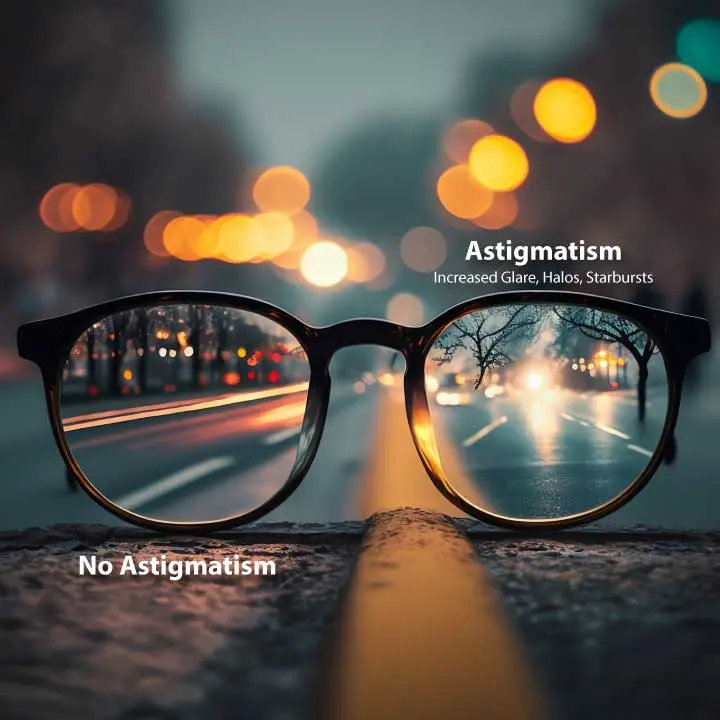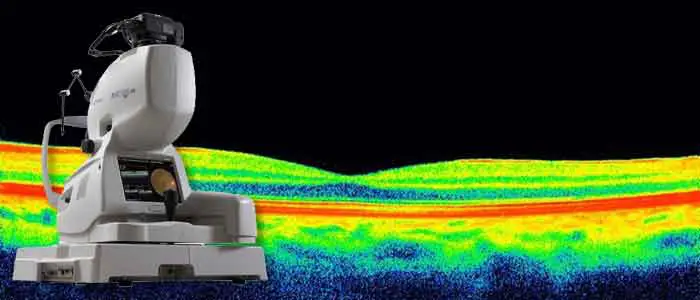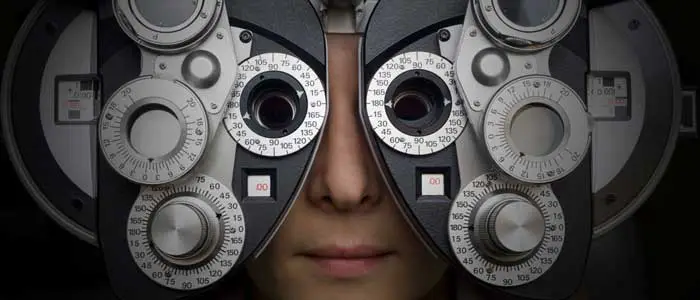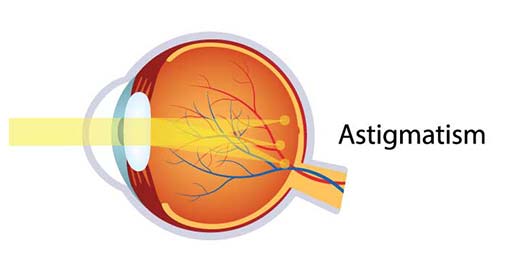Astigmatism
13-04-2022
What Is Astigmatism?
Astigmatism is a refractive error, meaning it is not an eye disease or eye health problem, but rather it's simply a problem with how the eye focuses light. In an eye with astigmatism, light fails to come to a single focus on the retina to produce clear vision. Instead, multiple focus points occur, either in front of the retina or behind it, or both. Astigmatism is very common, with more than 25% of the population having in one, or both eyes.The Cause Of Astigmatism
Astigmatism usually is caused by an irregularly shaped cornea. Instead of the cornea having a symmetrically round shape (like a baseball), it is shaped more like a football, with one meridian being significantly more curved than the meridian perpendicular to it. Genetics factors heavily into developing astigmatism, but eye injuries can also be a cause.Types Of Astigmatism
There are three primary types of astigmatism:- Myopic astigmatism. One or both principal meridians of the eye are nearsighted.
- Hyperopic astigmatism. One or both principal meridians are farsighted.
- Mixed astigmatism. One principal meridian is nearsighted, and the other is farsighted.
Correcting Astigmatism
Astigmatism, like nearsightedness and farsightedness, usually can be corrected with eyeglasses, contact lenses or refractive surgery. In addition to the spherical lens power used to correct nearsightedness or farsightedness, astigmatism requires an additional cylinder lens power to correct the difference between the powers of the two principal meridians of the eye.Symptoms Of Astigmatism
Astigmatism is a common refractive error that occurs when the cornea or lens of the eye has an irregular shape, leading to blurred or distorted vision. The symptoms of astigmatism can vary in severity and may include:- The primary symptom of astigmatism is blurred vision at all distances. Objects can appear fuzzy, both up close and far away.
- Astigmatism can cause objects to appear stretched, slanted, or distorted, particularly when looking at fine details or lines.
- Individuals with astigmatism often experience eyestrain, especially after prolonged periods of reading, using digital screens, or performing tasks that require focused vision.
- Persistent headaches, especially around the eyes, can occur due to the extra effort required to focus with astigmatism.
- Astigmatism can lead to difficulties with night vision, causing glare, halos, or starbursts around light sources.
- People with astigmatism may unconsciously squint to try to improve their vision, as squinting temporarily changes the way light enters the eye.
- Astigmatism can cause general eye discomfort, dryness, and irritation due to the strain placed on the eye muscles.
- Unlike some other refractive errors, astigmatism can affect vision at all distances, making both near and far objects appear unclear.

It's important to note that these symptoms can be similar to those of other vision problems or eye conditions. If you're experiencing any of these symptoms, a comprehensive eye exam by an optometrist is recommended to determine if astigmatism or another vision issue is the cause. Early detection and appropriate corrective measures can significantly improve your visual clarity and overall eye health.
Check out our index to learn more about other eye-diseases and disorders.
Schedule An Appointment
Adult Eye Exams
Our advanced eye exams consist of 25+ modern tests and digital scans to assess eye health, function, and visual acuity.

Child Eye Exams
Give your child a clear future with an annual eye exam from our experienced Edmonton optometrists.

Senior Eye Exams
Maintain your vision through your golden years with gold standard eye care from the optometrists at our Edmonton eye clinic.

Contact Lens Eye Exams
Our eye exams for contact lens wearers include test and digital scans to assess eye health, function, visual acuity, and lens fit.

Diabetic Eye Exams
Managing diabetes requires regular eye exams to ensure that diabetes is not causing irreversible vision loss.

Dilated Eye Exams
Dilating the eyes enables our Edmonton optometrists to see more of the eye so that you many never see less.
Our Edmonton Eye Exams Are Comprised Of 4 Phases Of Evaluation

1. Eye Exam Pre-Testing
Corneal Thickness | Intraocular Pressures | Visual Field
Pre-testing is a detailed process that gathers all necessary information for the optometrist in advance of the optometrist-administered eye examination. This process involves completing a detailed patient history, as well as a series of standard tests. Pre-testing is an essential part of the comprehensive eye exam process, providing valuable information and visuals for both the optometrist and the patient.
More About Pre-Testing »
2. Advanced Diagnostic Testing
Retinal Photography, OCT, Topography
eye-deology Vision Care differentiates itself from other clinics by having the most advanced modern diagnostic specialty testing equipment. Specialty equipment, such as a wide-angle high-resolution retinal imager, Optical Coherence Tomography (OCT), Humphrey Visual Field Analyzer and corneal topographer, ensures that patients receive the best comprehensive eye care.
More About Advanced Testing »
3. Optometrist Examination
Health Assessment & Disease Diagnosis
eye-deology Vision Care Edmonton optometrists perform a multitude of tests and assessments to evaluate ocular health, eye coordination, and visual acuity. In addition, they also evaluate the results of the tests and scans performed during pre-testing. As part of patient education, our optometrists also take the time to show and explain results to patients.
More About Doctor Exam »
4. Eye Glass Consult
Prescription | Lens Selection | Digital Fitting
If you require corrective lenses to improve your vision, our licensed opticians will customize their fit to your unique attributes, needs, lifestyle, and budget. Our opticians are happy to provide you with information about the latest eyeglass frame and lens technologies available so you can make informed decisions and begin seeing and looking your best.
More About Eyewear Consult »